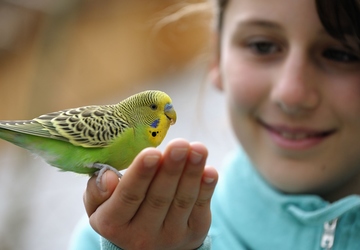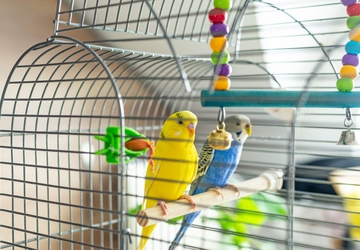Creating a complete environment for your feathered companion is essential for their well-being and happiness. Birds are fragile animals, and ensuring they are safe in your home can prevent many health complications and ensure they live long, happy lives.
Choosing the Ideal Cage
The Right Size
The right cage is the cornerstone of a safe environment for your poultry. Ensure the cage is large enough for your bird to move freely, spread its wings, and play. The cage bars should be properly spaced to prevent your bird from escaping or getting entangled in them.
Materials and Design

Choose a cage made of non-toxic materials. Avoid cages that contain lead or zinc, as these substances can be harmful if ingested. Stainless steel or powder-coated cages are preferred, offering a safer option. The design should include a safety lock to prevent accidental escape.
Optimal Placement
Avoid drafts and direct sunlight. Do not place the cage in areas exposed to drafts or direct sunlight. Birds are sensitive to temperature changes, and both extremes can be harmful. Make sure the cage is in a stable thermal environment.
Safe and Quiet Location
The cage should be placed in a safe, quiet area where the bird can interact with its family but not be overwhelmed by constant noise. High-traffic areas can be stressful for birds, so choose a quiet spot to create a bird-safe home.
Safe Toys and Accessories
Non-toxic Toys
It's important to provide toys, but make sure they are non-toxic and safe for your bird. Avoid toys with small parts that can create a choking hazard. Bird safety tips include regularly checking toys for wear to avoid accidents.
Perches and Climbing Frames
Use natural wood perches and climbing frames. Avoid perches covered in sandpaper, as they can cause foot injuries. Perches of varying sizes and textures help keep your bird's claws healthy and are essential for a bird-safe home.
Safe Food and Water
Fresh, Nutritious Food
Provide a balanced diet of seeds, pellets, fresh fruits, and vegetables. Do not give your feathered companions substances such as chocolate, caffeine, alcohol, or avocados, as these can harm their health. Providing fresh, uncontaminated water daily is an important aspect of ensuring a safe habitat for poultry.
Avoid Contamination
Use stainless steel or ceramic bowls for food and water, as plastic can harbour bacteria. Clean bowls daily to maintain hygiene and prevent the spread of pathogens.
Hazards in the Home
Toxic Plants and Fumes
Many indoor plants are toxic to birds. Keep plants such as lilies, philodendrons, and poinsettias out of reach. Also, avoid using non-stick cookware, as fumes can kill birds. To ensure a safe environment for your pet bird, it is important to remain vigilant about household poisons.
Power Cables and Open Water
Birds tend to chew on electrical wires, which can be dangerous. Use cable covers or keep cables out of reach. Also, ensure there are no open water sources, such as aquariums or sinks, that your bird could accidentally fall into.
Supervised Out-of-Cage Time
Safe Play Areas
Letting your bird out of the cage can create a designated play area free of hazards. Always supervise your bird to avoid accidents and keep it safe.
Safety of Windows and Mirrors
Birds can easily be injured from collisions with windows or mirrors, as they are often unaware of these obstacles. Use stickers or curtains to make your bird aware of these surfaces. This is an important step in creating a bird-safe home.
Regular Health Checkups
Veterinary Visits
Regular visits to the veterinarian are essential to monitoring your bird's health. A professional can provide bird safety tips based on your bird's species and needs.
Observe Behavior
Check your bird's behaviour and appearance. Deviations may indicate underlying health complications. Responding quickly to signs of distress can improve your feathered companion's health.
Environmental Enrichment
Mental Stimulation
Provide mental stimulation through toys, puzzles, and interactions. Bored birds can develop destructive behaviours. To ensure your pet bird has a safe environment, you need to keep them mentally engaged.
Social Communication and Bird Sociability:
Birds are naturally social animals and require essential interactions with their human flock. Schedule a time each day for conversation, play, and to build a strong emotional bond with your bird. This interaction is essential to creating a bird-safe habitat where your feathered companion feels deeply protected and cared for.
Hygiene and Perfection

Pristine Habitat Areas:
Continuously disinfect enclosures, seating structures, and play equipment to prevent the spread of microbial and fungal contaminants. Maintaining a pristine environment is an important part of creating a bird-safe home.
Safe Cleaning Products:
Use cleaning products that are safe for birds. Many household cleaners contain chemicals that are harmful to birds. Choose natural or bird-specific cleaning solutions.
Emergency Preparedness
First Aid Kit
Prepare a bird-specific first aid kit. Keep items such as styptic powder, disinfectant wipes, and bandages handy. Knowing how to treat minor injuries is part of maintaining a safe environment for your pet bird.
Emergency Contacts
Have contact information for your avian veterinarian and local animal emergency clinic ready. It is critical to get professional help quickly in an emergency.
Air Quality and Ventilation
Ensure Fresh Air Circulation
Adequate ventilation is essential to maintaining a safe environment for your pet bird. Use a HEPA air purifier to eliminate airborne particles and toxins. Do not place cages near HVAC systems, as sudden temperature changes can be harmful.
Avoid Chemical Exposure
Be careful when using cleaning products, perfumes, and aerosols. Many contain volatile organic compounds (VOCs) that are harmful to birds. Choose hypoallergenic or bird-safe alternatives to maintain a safe environment for your pet bird.
Lighting and Circadian Cycle
Natural Light Exposure
Ensure your bird has access to natural light, which is essential for its physiological homeostasis and circadian rhythm. Place the cage near a window away from direct sunlight to avoid overheating.
Artificial Lighting
If natural light is insufficient, use full-spectrum lighting to replicate solar radiation. This will help your bird maintain endocrine and metabolic function. Proper lighting is an important part of bird-proofing your home.
Noise Control
Minimize Noise
Birds are highly sensitive to hearing and can be easily disturbed by harsh or sudden noises. Place the cage in a quiet area away from sound distractions such as televisions or speakers. This is an important aspect of bird safety tips.
Soothing Sounds
Play soft, soothing music or a natural soundscape to create a calming environment. This can reduce stress and create a sense of security, helping to create a bird-safe home.
Interaction & Socialization
Regular Human Interaction
Birds are naturally social and require regular interaction with their human keepers. Make sure you spend plenty of time talking, playing, and interacting with your bird to strengthen your bond and ensure his psychological well-being.
With Other Birds
If you live with multiple birds, follow a careful reunion protocol to avoid arguments. Supervised interaction fosters harmonious coexistence, which is essential to creating a bird-safe home.
Conclusion
Following these bird safety tips ensures your feathered companion enjoys a safe pet bird environment. Remember, creating a bird-safe home is an ongoing process requiring vigilance, care, and affection.















